

This page is a postcard type site with images and comments that takes time to load-up. The images came from many sources, to name a few, Australian War Memorial, Harry Smith, Ron Eglinton, Denis Gibbons and 6RAR Pictorial History of the 1966-7 Viet Nam tour.
"All Guts and No Glory" is my Viet Nam story published through Allen & Unwin, Australia. It is available through most book stores and incorporates some of the images displayed on this site. Should you enjoy this page may I suggest you read the book.
ONLINE ORDER direct from publisher
All guts and No Glory The Battle of Long Tan as told by The Commanders" - Through Enemy Eyes information will be included when available
 February 2005
February 2005

Now there will be an epic movie of The Battle of Long based on the book "The Battle of Long Tan as told by the Commanders" is to be an all Australian effort. A battle and war story fought and told by Australians.
See Red Dune Films for details
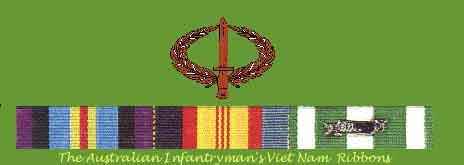
Infantry Combat Badge
Australian Active Service Medal - Vietnam Medal - Viertanese Medal
Looking to the west towards the 1st Australian Task Force base across the rubber plantation near the village Long Tan (left out of frame), South East of Ho Chi Minh City (Saigon) where, on the afternoon of 18 August 1966 the "Battle of Long Tan" was fought, between my company, D Company of 6 Battalion Royal Australian Regiment (6RAR) only numbering 108 against elements of the 5th VC Division, namely, 275 Regiment reinforced by a North Vietnamese Battalion and D445 Provincial Battalion, an estimated total strength of 2,500.
This photograph courtesy Ross Goldspink of 161 Independent Recce Flight (1967)
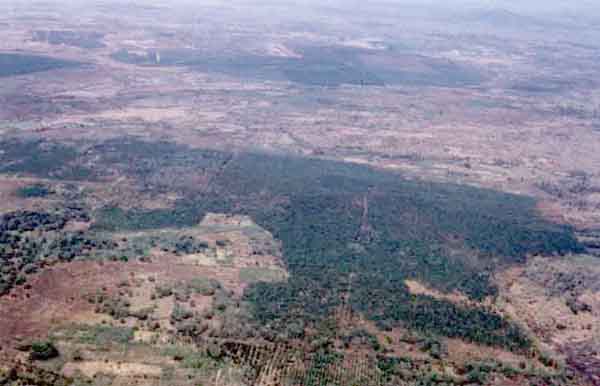
I went to Vietnam in 1966 with the 6th Battalion Royal Australian Regiment, a Platoon Sergeant with D Company, an Infantry Company.
I have placed links throughout this page to a site that is dedicated to those who served in Viet Nam. This page was created and maintained by Ern Marshall of Mildura, Victoria, Australia. Amongst his pages there is more information on the "Battle of Long Tan", including sites that questions the Viet Cong's (VC's) intentions on this day, and, what they reported as a successful ambush action.
Information I received (April 1999) reports that VC produced new diaries for all commanders, detailing an ambush was successfully conducted against the Australians including their victory results. Within days of the battle this report was then broadcasted by Hanoi Radio and Radio Peking (Beijing). It was propaganda only believed by the most gullible. One Australian author, a soldier with D Company and present at the battle believed this communist twisted defeat into victory and published a book stating that the company was ambushed. This act has distorted the history and facts and promoted the propaganda initiated by the enemy to save face. The facts are here, supported by documentation, through links, for all to read and determine for themselves what happened on that day when 108 young men went for a walk through a rubber plantation on that day.
This link "WHO DID WIN THE VIET NAM CONFLICT?" is included to explode the myths generated by the world press and others who were duped by the communists and socialist propaganda supporting the North Vietnamese invasion against the Republic of South Viet Nam.
\A Cross was erected at the 11 Platoon position for the battle by 6RAR on 18 August 1969, the second and last tour of duty by the battalion. The brass plaque at the centre of the cross had been stolen when this picture was taken some years later. Since the cessation of hostilities the brass plaque has been located. This, the original cross, had been taken down and discarded only later to be recovered and is now located in the Vietnamese War Museum at Bien Hoa City......... A duplicated cross now stands with a Vietnamese Memorial at the battle site.
The Cross and battle site have become an unofficial War Memorial for visiting Australians and New Zealanders.
D Company Roll of Honour of those who served with 11 Platoon 1966-67. One did another tour to Vietnam and was KIA.
Rick ALDERSEA, Glenn DRABBLE, Richard CLIFF, Ken GANT, Ernest GRANT, Vic GRICE, Jim HOUSTON, Jack JEWRY, Jack KIRBY DCM, Barry KELLY, Paul LARGE, Col LITHGOW, Ken MATHIESON, Albert McCORMACK, Dennis McCORMACK, Warren MITCHELL, Doug POWTER, Doug SALVERON, Gordon SHARP, Dave THOMAS, Frank TOPP, Max WALES, Colin WHISTON and Jeff DUROUX on his second tour.
Manning details 18 August 1966
The Long Tan Cross and environs restoration was completed in April 2002 to read how this was achieved please follow this link to
My company, D Company 6RAR, Vietnam 1966-67, recorded the highest casualties inflicted on any Australian Combat Company during Australia's ten year involvement in Vietnam.
D Company’s casualties for the 1966-67 tour, 23 KIA (killed in action) and 47 WIA (wounded in action). The operational strength of an Australian Infantry Company being about 120.
Besides Long Tan, the company endured a VC mine incident and many contacts with the enemy. 11 Platoon suffered 1 KIA and 10 WIA during November 1966 from a mine.
Then early in February 1967, D Company suffered 4 KIA and 13 WIA. This was due to 12 rounds of friendly artillery fire impacting the company headquarters and a platoon, caused by a plotting error.
I commenced to write text only and after reading a paragraph or two of text I became disinterested, so I have assembled this post card presentation based on a manuscript I wrote, Now published as "All Guts and No Glory".
I hope you enjoy it.
Being a professional soldier
in the Australian Army during the period 1959 to 1980 it was exciting and an
extremely interesting job. There was a saying in those days and it went something
like this. "Join the Army, visit exotic and strange places and when required,
kill."
Today, 2001 (updated from 1997), the politically correct zealots do not accept
this type of statement or rhetoric. I do not belong to their group and never
will accept their bigotry.
Infantry soldiers in a Combat Company have no time, need or want to take
photographs of the death and destruction they inflicted and surrounds them on
the battlefield. They are happy to be alive after any encounter with the enemy
and joked about what happened.
I suppose soldiers from all armies do that, joke about life threatening incidents that left them untouched, as a way of releasing the pressure inside, I know I did. There is no blood and guts in my pages, it will show how we developed our home base, were we lived, and a series of maps sequence of dispositions of groups involved in the "Battle of Long Tan". In general how it was over 30 long years ago at a place called Vietnam.
A place few knew about and a handful experienced. Those that did, will never forget.
|
|
The family during May 1966 and about two weeks before flying to Vietnam. This photo was on the table in my tent for the whole tour and I still have it after thirty years Beverley, Tracey (13 months) and Bob. We were to be separated for nearly 13 months.
|
|
This was the only accommodation available to all male recruits until the late 1960's. The Nissen Hut, a water tank lying down. The First Recruit Training Battalion is located at Kapooka, near Wagga Wagga central New South Wales.
This photo courtesy of Ron Eglinton showing the 1st National Service intake at Kapooka July 1965. Some of those recruits in this image served with me in Viet Nam. Sadly some were killed or wounded.
|
|
|
|
Study this map of South East Asia, prior to 1955, Thailand was then Siam, Indo China, a French Colony, consisted of what is now Laos, Cambodia and Vietnam. After WW2 the French reoccupied the colony. The Viet Minh under the leadership of Ho Chi Minh commenced the 1st Indo China War and defeated the French in 1954. Vietnam was then divided into North and South Vietnam under an agreement signed at Geneva. North and South were to reunite but the 2nd Indo China started during the late 1950's. This conflict continued until 1973 with the signing of a "Peace Accord" in Paris. Allied forces withdrew, South Viet Nam's army was downsized, the North Vietnamese Army had moved to Cambodia and Laos and again invaded the south in 1975 defeating the South in April that year. 1962 Australia sent Military Advisors to join the Americans in training the South Vietnam Forces. The Viet Cong, ex Viet Minh, had control of most of the countryside and the South Vietnam Government had little control of the majority of the population. 1965 Australia sent an Infantry Battalion Group to Bien Hoa near Saigon, (Ho Chi Minh City). This group of Australians were attached to the US Army 173rd Airborne Brigade (Independent). 1966 that battalion group was replaced by a 2 Battalion Battle Group, the 1st Australian Task Force (1ATF). 1ATF moved in to Phuoc Tuy Province and stayed until December 1972 when all Australian operational forces withdrew . 1967 the Task Force increased to include another battalion and tank squadron. About 500 New Zealand soldiers were also part of the Task Force.
|
|
The Jungle Training Centre (JTC),
Canungra, Queensland like Kapooka had a reputation of being a place you only
ever visited once.
|
|
|
|
The three Platoon Commanders in D Coy, 6RAR.
L to R Geoff Kendall (10 Pl), Gordon Sharp (11 Pl KIA) and David Sabben (12
Pl). Jack Kirby seen between Kendall and Sharp. They, like eighty percent of
the company, had been in uniform for only a year.
|
|
August to October is the
monsoon season in South Vietnam, because everything was always wet, muddy and
mildewed, it was not the place to go for a holiday.
|
|
**************************************
The following maps show the positions of opposing forces during the 3 hour battle.
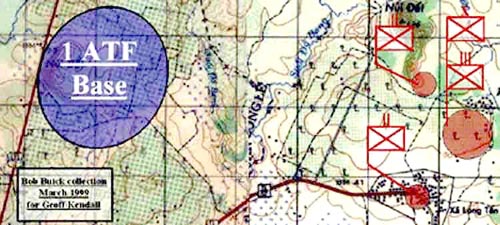
This map indicates the area occupied by the Australian at 1st Australian Task Force (1ATF) base and about 5 to 6 kilometres to the East, the 5th VC Division consisting of 275 Regt, D440 Battalion, D445 Battalion and an unknown North Vietnamese battalion.
This map, and the others to follow, is divided into squares with 1000 metre boundaries, or about two thirds of a mile. The whole battle was fought within the lower half of one of these squares. This square being the second from the right and second from the top, in the plantation between the hill in the north and track aligned NW/SE. It was all very concentrated and intense for the 3 hours. By comparing the maps you will be able to understand what happened that day.
|
|
This image shows the locations of units and elements of D Company just prior to the battle. The red star indicates the initial contact with a VC patrol. We never knew that the VC were in the area until that contact. 11 Platoon advancing East and was fired on by 2 machine guns and rifle fire from the North, from the southern slopes of Nui Dat 2. An estimated VC company quickly attacked from the north. 1000 metres to the East was 5th VC Div HQ's and another 2 or 3 battalions. About 1000 metres to the South, in an abandoned village of Long Tan, was another battalion, D445 the Provincial Battalion. Most of the 4 battalions were involved in the battle. The yellow bursts indicate artillery fire missions with the times fire. In all cases adjustments would have been made from the initial location.
|
|
1Hour into the battle and 11 Platoon was being attacked from the North and East by two VC company groups numbering a total of 160. The platoon had 6 dead and 6 wounded had only 20 warriors capable of fighting. 10 Platoon, 150 metres to the Northwest trying to help 11 Platoon, encountered a VC company moving to encircle 11 Platoon. Supporting artillery fire (the yellow circles) was too far away to give effective fire support to 11 Pl. The battle stalemated, the VC had no idea what size force they had encountered. A crucial time for both sides, 11 Pl defending their ground to the death and the VC continually dying to take it. All assaults were repulsed by machine gun and rifle fire. A fierce monsoon storm developed of the battlefield during this time. It seemed as if Armageddon has arrive with lightning , thunder and rain so dense that visibility was reduced to less than 100 metres. |
|
|
|
During the second hour the VC continued to attacked 11 Platoon in strength, assaulting from the East and South East in company groups, estimated to be 80 strong. The original enemy group on the platoon’s left (North) giving small arms fire support to the attacking forces. The platoon was receiving accurate small arms fire from three sides. 10 Platoon, with about six casualties had moved back to the main company position some 400 metres to the West. West of 11 Platoon, 12 Platoon with only 2 squads (total 20,) had moved to within 200 metres of 11 Platoon's rear. They too were attacked by the VC who moving to encircle 11 Platoon from the south. The artillery fire was adjusted to fall 50 to 75 metres to the front (East) and right (South flank) of 11 Platoon. The initial 12 rounds of 105mm high explosive amongst 150 attacking VC stopped them completely. |
|
After nearly three hours, 14 members of 11 Platoon made it back to
12 Platoon, 15 dead remained on the battlefield, but two were found alive the
next morning. 12 Platoon, with some of 11 Platoon (the platoon was split of
the withdrawal) then withdrew to the company defensive position. The company
had formed a tight perimeter about 80 metres across to defend itself against
attack. With little ammunition left Australian helicopters dropped an ammunition
resupply just in time. There was only about a 1,000 rounds of small arms ammunition
in the company, a few rounds per man before the resupply. |
|
The battle was nearing the end.
Three Troop, 1APC Squadron, with Alpha Company 6RAR on board, passing through what was thought to be artillery fire, now identified as most likely to be VC mortar fire as there was no artillery fire mission in that area, with the crews firing their machine guns, assaulted D445 VC Battalion some 1000 metres south of the beleaguered Delta Company. The final assault of the battle was by 3 Troop and Alpha Company as they turned to the East . The enemy force moved Eastwards as total darkness enveloped the battlefield.
Bravo Company, 6RAR, numbering some 40 in total, returning to base had been stopped when the battle started. This is the group that Delta Company had relieved also arrived reinforcing Delta some ten minutes before the main reinforcement group that arrived at about 1900 hours (7:00 PM).
**********************************
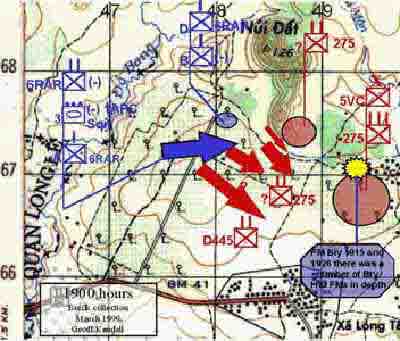
Like in a movie, in the nick of time and with guns blazing the cavalry arrived, the enemy broke contact and melted away in the dark going back to the East.
The battle was over.
**********************************
6RAR at midnight moved to the western edge of the plantation to evacuate the wounded. Helicopters, a USA Dustoff [Casualty Evacuation Helicopter] and about six helicopters from 9 Sqn RAAF, arrived at about 0100 hours, and with no landing lights came in to pick up the dead and wounded. 11 Platoon had 15 warriors missing, left on the battle field.
The following morning we assaulted the battle area expecting another all in fire fight with the enemy but the VC had fled leaving 245 to be buried and 3 wounded, who became prisoners.
We recovered the 13 dead and 2 wounded Aussies and all their equipment. The VC did not touch the Australian dead but removed one back pack. That pack was recovered when a VC was killed by B Company 6RAR some 3 months later.
This battle was the biggest and longest daylight action the Australians had in Vietnam.
106 Battery of the Royal Australian Artillery was not in Vietnam for Long Tan, but, like those Aussie and Kiwi gunners that did supported D Company at Long Tan, they supported other Infantry Warriors .
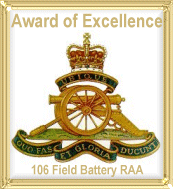

155mm Mobile Artillery - 2/35th US Artillery

This medal, the South Vietnamese Cross of Gallantry, was to be awarded to 22 soldiers of the Australian Task Force for the Battle of Long Tan by the Vietnamese government. Approval was finally granted to the wearing of this medal during 2004 some thirty-eight years after the event.
The background to this medal fiasco
|
|
Jim Richmond of 11 Platoon was seriously wounded
from the initial enemy fire at about 1540 hours on the 18th. This images shows
him receiving treatment for his chest wounds on the morning after the battle.
Attending Jim, are "Jordie" Richardson a Bandsman stretcher bearer
facing the camera and Bob Buick, Jim's Platoon Sergeant. The battlefield was a charnel house with hundreds of dead strewn everywhere. The rubber trees had been shattered from the artillery and streaming ribbons of latex from trunks where bullets and shrapnel had slashed the bark.
|
|
The 105mm Artillery Field Gun used by the Australian and New Zealand Batteries was designed by the Italians for mountain warfare. It was never designed to fire high rates of fire for over three hours. It fired a 15 kilogram High Explosive shell about 9 kilometres. At Long Tan, the 6 to 7 kilometres range was the ideal range for this type of gun. Capable of high accurate and sustained fire at that range, each gun firing a round every 10 to 15 seconds. For over 3 hours, 18 of these guns supported D Company. It requires dedication and skilled gun crews to attain such a high standard of gun fire in battle support. After this battle these guns were replaced by the American 105mm field gun. |
|
|
|
There was not a great quantity of enemy weapons
recovered after the battle. During the night, after 6RAR withdrew for casualty
evacuation, the VC returned to the area. Their mission was to recover as many
weapons as possible along with as many dead and wounded as could be handled.
|
|
Three Viet Cong were captured, 2 from the provincial D445 VC Battalion the other a 17 years North Vietnamese. D445 battalion was targeted by 1ATF as the main enemy. After Long Tan and over the next couple of years the battalion was reduced to less than a company strength of 80 and very restricted in its operations. If we never knew much about the enemy and his plans, the captured soldiers knew less. One stated that his battalion was ordered to march to the sound of the firing, and that they did not know who they were fighting or how many. Neither side knew what the other did during this battle. We have told our story but this has been rejected by the Vietnamese military history writers. They maintain there was over a battalion of Australians in the rubber plantation, there was not, we were only a company with a strength of 108. Our enemy have blended and concocted a tale to suit they political aims.
|
|
|
|
Jack Kirby (awarded the Distinguished Conduct Medal, DCM) and Harry Smith (awarded the Military Cross, MC) for their actions at the battle about to test fire the captured wheeled Soviet Machine Gun. Jack was killed when 12 rounds of 105mm friendly gun hit fell on D Company February 1967. |
|
Called "a slick" this type of helicopter was the taxi to the Infantry Soldier. Carrying 7 Australian's with all their combat equipment to any part of the province in 20 minutes.
|
|
|
|
Some of the 11 platoon survivors play with
water! Peter Ainslie, Ron Yow Yeh and Ron Eglinton giving instruction to Geoff
Holmes on how it should be done. Or, is he indicating the depth of water?
|
| D Company Digger lines
completed and comfortable by about February 1967.
After 7 months of building the defences, patrolling and conducting many operations, the home comforts were also completed. Sleeping 4 to a tent, furniture was made from boxes and other equipment scrounged. Aussie don't steal, they acquire or scrounge. In Vietnam there was a lot of both. |
|
|
|
After Long Tan there was about a week
of "panic wiring". The defences at the time of Long Tan could be said
to be poor and extremely basic. By February 1967 D Company had erected barbed wire defences about 100 to 150 metres deep. This image shows Harry Smith looking at the area on the company's right flank, adjacent to the Task Force Support Units. |
|
|
Our enemy, the Viet Cong and the North Vietnamese Army lived in the bush, tunnels and caves.
Constantly threatened from ground and air attack he had no real place to call home. Yet, with all these constraints he survived and finally defeated the South Vietnamese Forces in 1975.
|
|
A Viet Cong Mortar Crew training.
These crews were expert in handling and firing the mortar. This a 82mm Chicom
mortar had a longer range than the US 81mm mortar.
|
|
|
|
D Company in camp, at home for Christmas. Each platoon or group within the company was required to perform. This is the headquarters strutting their stuff.
Where they got the sheila (girl) is left to the imagination.
They looked familiar, the signallers and medics in drag. "Priscilla Queen of the Desert" in the jungle of Vietnam.
|
| The soldiers mess, kitchen and club (boozer), this image was taken about March 1967, 8 months after arriving at Nui Dat. It was the dry season and these facilities had little use due to operational requirements. In the bush looking for the VC. |
|
|
|
Officers and Sergeants in the Australian Army had separated amenities to the soldiers. This is their club with a farewell party on the last day in country. Harry Smith the Company Commander with the Australian Red Cross girls Jean Debelle and Winsome Ayliffe. Called "Dough Nut Dollies" by the Americans, we thought more of them than that.
|
|
HMAS SYDNEY, fondly called "The Vung Tau Ferry" photographed here north bound to Viet Nam taking on fuel and supplies from a Fleet Tanker . Australia's three services served in Vietnam. The Navy with Warships, Pilots to US Army Helicopter Assault Companies and Mine Clearance Divers to US Navy Seal Teams. The Air Force with Bombers, Caribou Transport Planes and Huey Helicopters that were in direct support to 1ATF. Some 60,000 Aussie's went to Vietnam and that included civilian medical and aid teams. |
|
That then is my story in picture magazine form. I trust that I have shown in general what it was like. Operational and battle images really give a true image on what conflict is all about. This can only be passed by voice and text, most movies cannot really portray the true image, but, some or close.
With the awarding of the Australian Unit for Gallantry Citation (October 2009) to D Company 6RAR (Vietnam 18 August 1966) for their performance at the Battle of Long Tan the following unit citations are worn by those of this company on the right breast when wearing medals, level with the medals and in the order as seen below, when looking at the individual.
The United State created unit awards of various levels during and post Second World War the highest being the Presidential Unit Citation (US PUC), the Republic of South Vietnam did the same and the Cross of Gallantry awarded is compared to the US Meritorious Unit Commendation (US MUC). Australia in 1991 developed a similar unit award system with The Unit Citation for Gallantry (UCG) (similar to the US PUC) and the Meritorious Unit Citation (MUC) that is similar to the US Meritorious Unit Commendation.
Link to a page showing the Australian Gallantry awards and Foreign Awards
Information to foreign unit citations and medals here

Australian Unit Citation for Gallantry Company 2009

United States Presidential Unit Citation Awarded to Company 1968

Vietnamese Cross of Gallantry Citation Awarded to Company. Permission to Wear 2006
During 2008 a review to the awarding of Imperial Awards to then Major Marry Smith the Military Cross [MC] and 2Lt Dave Sabben and Geoff Kendall - Mention in Dispatches, was conducted. The review found that there were anomalies to the procedures to these awards. Subsequently all three were upgraded to the Australia awards equivalent to the recommended Imperial Awards.
Harry Smith recommended for the Distinguished Service Order to the Star of Gallantry
Dave Sabben and Geoff Kendall recommended for the Military Cross to the Medal of Gallantry
View these medals and the Australian Unit Citation emblems.
During Vietnam many hundreds of warriors completed many gallantry acts and actions above expectation. They were, either never recommended, or had their awards downgraded due to a system that was developed in the 1914-18 World War, refined during the 1939-45 World War. The Australian government committed its armed forces to the Vietnam War in the 1960s using WWII equipment and administrative procedures. The government's action has been demonstrated to be a lasting and shameful indictment to the ineptness of themselves at the time.